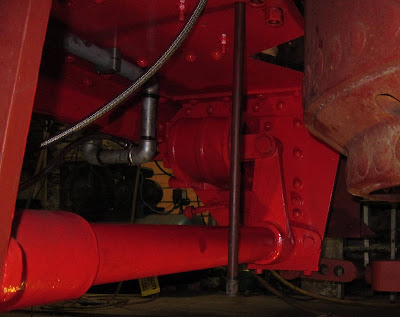Now things are starting to get interesting. Testing is where you find out what you got wrong and get the chance to put it right.
Putting it right is best done by first privately figuring out how to do it and then showing onlookers what is wrong but apparently instantly coming up with the solution. It's best done this way; nobody notices if you get it right first time!
The first simple test is to show that the vacuum pipework does not leak excessively. (In actual fact, it does not matter if the system leaks but it does matter if it leaks so much that the vacuum ejector cannot suck hard enough to overcome the leaks and pull the train brakes off. This is inherently safe on a loco but undesirable on a carriage or wagon with vacuum brakes).
I sealed the rear vacuum end with the usual blanked-off, dummy coupling.
 |
| Blanked-off vacuum hose coupling |
I attached the front end to a vacuum brake tester which I constructed about six years ago (much easier than shunting a loco to do the job and much more controllable).
 | The narrow hose links to the tester shown on the right.
The black vacuum pump is a Seco type SV1040C supplied by Busch and can pull 24 cu ft/min. |  |
The brake tester can evacuate the system to the required level (21" Hg) to exercise the vacuum relief valve and enable the brake lever to perform its function.
 |
Blue brake lever handle with relief valve behind and silencer in front
More detail here |
|
|
Powering up the tester draws the 21" Hg (left).
Opening the brake valve drops the vacuum (right)
|
|
It's much better illustrated with a video: (Also on YouTube).
The 'whirring' noise is the tester motor
The tester has a non-return (check) valve such that when it is switched-off, the vacuum is held. In this way, leaks can be detected by watching the time it takes for the vacuum to drop.
Although the tester itself leaks a tiny bit, initially there were obviously some pipework leaks; however after tightening all the pipework unions (all other joints are sealed with Heldite), it was deemed to be satisfactory (with the brake test unit, that is, not the ejector itself - that's another test!).


















































